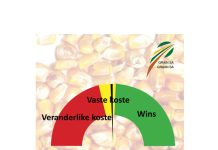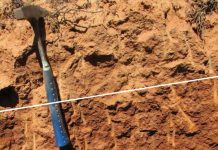Soil is the most fundamental resource for the farmer, without which food and natural fibre cannot be produced. The mineral fraction of soils originates mainly from geological material. This article aims at highlighting the influence of a few of the most important and common geological parent materials on the composition of soil.
A rock or type thereof is sometimes made up of a single mineral, but normally consists of a complex of various minerals. When the rock weathers, these minerals form the primary source of the mineral fraction of the soil. These different minerals, in turn, give rise to various soil properties. Should the parent material of soils in a specific area thus be known, various assumptions about the properties of the soil in that area can be made.
Rocks are classified into three main groups according to their origin, viz. igneous, sedimentary and metamorphic rocks.
Igneous rocks
Igneous rocks originate from melted magma which has cooled and solidified. The chemical composition of the specific magma and the cooling rate thereof have a determining effect on the properties of the rock.
Granite
Granite is common in Southern Africa and often covers large areas. Because it cooled deep under the earth’s crust, the granite had ample time to crystallise and therefore the granite’s crystals are relatively large. The typical composition of granite is indicated in Table 1.

The quartz fraction is hard, chemically non-reactive and therefore weathers slowly. Quartz thus forms the largest fraction of a soil that has weathered from granite. The sand fraction is mainly coarse, the angles are sharp and therefore cause more wearing on soil tillage implements. The other minerals (feldspar and mica) weather relatively easily to provide building blocks for the formation of silicate clays.
Because granite weathers to a sandy material, it is leached and acidic in regions with a high rainfall. The K-feldspar provides lots of potassium to granitic soils, but usually provides little Ca and Mg. The landscape in a granitic area usually comprises rounded “domes” with narrow marshes between the domes.
The soil types on the dome tops are usually red and sandy with yellow sands further down the slope. The clay fraction then accumulates in the marshes to form clayey soils. The sandy nature of granitic soils make it prone to compaction and the formation of compacted layers must be monitored regularly and lifted by deep ripping.
Dolerite
Dolerite was formed when magma penetrated the earth crust through cracks and fissures and solidified relatively slowly, albeit faster than granite. The intrusions were either vertical, forming dykes or horizontal, forming plates. Dolerite is quite hard and often weathers slower than the rocks into which it has intruded. This results in a landscape formation of series of ridges or the so-called “mesas”. Dolerite is especially associated with the Karoo sediments.

Dolerite crystals are finer, comprising dark minerals (Table 2) and have a total absence of quartz. The minerals are all building blocks for clay minerals and, for that reason, dolerite soils are clayey. The sand fraction comprises semi-weathered minerals and should quartz occur in the soil, it has been imported by wind and/or water.
The minerals are rich in Ca and Mg, but are low in K. Na fro

m the plagioclase has a major influence on the physical condition of the soil, especially if it accumulates lower down in the landscape and causes the soil there to be brackish. Ca from the plagioclase could lead to the formation of limestone reefs. Fe from the augite and magnetite results in soils in well drained areas of the landscape being coloured intense red, while the marshes are typically rich in swelling clays.
Basalt
Basalt is lava that flowed out on top of the earth’s crust and thus cooled down rapidly. Mineralogically, it is closely related to dolerite. Basalt is especially plentiful in South Africa as the uppermost rocks of the Drakensberg where it overlies the sandstone, as well as on the Springbok Flats north of Pretoria.
Those soils originating from basalt, are similar to those of dolerite, namely clayey red and black soils. Natrolite and quartz often crystallised in the gas bubble pores.
Ventersdorp lava
Ventersdorp lava is common in the North West Province, where it weathers to clayey soils. Especially in the Northwest Province it is covered by a layer of aeolian sand, where it typically gives rise to a sandy topsoil and a very clayey subsoil.
Ventersdorp lava mineralogically partially corresponds with dolerite and basalt and is also rich in calcium and sodium plagioclase and augite. Contrary to dolerite and basalt it contains quartz, epidote, chalcedony and chlorite that crystallised in the gas vents.
Sedimentary rocks
These are rocks that were formed from weathered material originating from other rocks, which were transported, deposited, and consolidated to form a new hard rock. Sedimentary rocks are consolidated under pressure from later deposits that form an overburden to create a hard rock and are subdivided according to particle size.
Shale and mudstone
Shale is very wide-spread in Southern Africa, where it forms one of the lower layers of the Karoo sequence. Shale and mudstone form when silt and clay are transported by water and deposited elsewhere in layers. Shale is characteristically layered and has a fine texture. Mudstone is similar in texture, but is not layered.
Shale and mudstone both weather to form clay minerals, fine quartz grains (silt) and other minerals, such as feldspar and mica. Some shale rocks are rich in sodium and give rise to Na soils that are exceptionally susceptible to water erosion. Examples are to be found in KwaZulu-Natal and the Eastern Cape.
Sandstone
Sandstone is common in South Africa. The most well-known sandstone is that of the Karoo sediments where it occurs on top of the shales and forms part of the Drakensberg in the Eastern Cape, the Eastern Free State, Mpumalanga and Limpopo. In the Southern and Eastern Cape the so-called Table Mountain sandstone also occurs and is lifted from the bottom of the sea.
Sandstone in South Africa mainly comprises quartz sand deposited by wind or water and thereafter cemented together by a binding material (such as silica, calcium carbonate, iron oxides or clay) to a massive rock. The sand grains of sandstone are still clearly visible and sandstone breaks between the grains of sand. Sandstone is characteristically layered. Mineralogically, sandstone mainly comprises quartz, but can also contain large quantities of feldspar.
When sandstone weathers, it forms to more or less the same soil as the original parent material from which it was composed. The vast majority of sandstone in South Africa forms sandy soil. These soils are commonly highly leached and tend to be very acidic, especially the Table Mountain sandstone soils.
Conglomerate
Conglomerate is made up of both coarse and fine material and/or rock fragments. The finest are clay and iron oxides, while the largest may comprise pieces of rock larger than a metre. The parent material of conglomerate was transported by water or glaciers and deposited as unsorted and unconsolidated material.

This unconsolidated material was later cemented into massive rocks by fine material such as clay, iron oxides and lime. Thus, mineralogically it comprises a mixture of rocks and minerals, which could lead to a variety of soil types and soil properties. The combination of minerals in the parent material, the topography and the climate are therefore the main driving forces that will determine the specific soil type.
The most important conglomerates can be found in the Northern and Western Cape, where it was deposited as glacier material. These conglomerates often contain rolling stones of various sizes.
Metamorphic rocks
When any rock (igneous, sedimentary or metamorphic) is changed physically, usually by high pressure and temperature, so that it differs morphologically from the original rock, the “new” rock is known as a metamorphic rock. Chemically, it is still basically the same as the original rock, but can now be for example, harder and less crystalline.
Quartzite
Quartzite is a metamorphic sandstone and is common in South Africa. The best known quartzite is that of various mountain ranges like the Magalies Mountains, the hills of the Witwatersrand, the Waterberg Mountains and the folded mountains in the Cape.

Quartzite is also characteristically layered (banded), as inherited from the parent material. The sand grains are also still clearly visible, but when quartzite breaks, it breaks through the sand grains (since the binding material is now harder than the sand matrix). Quartzite mainly comprises quartz, but may contain other impurities inherited from the sandstone. It is very hard and offers strong resistance to weathering. It does weather physically such as, for example, when stones roll over and chip each other, thus forming sand once again. Soils evolving from quartzite are sandy and tend to be leached and acidic, especially in high rainfall areas.
Other common metamorphic rocks are schist, gneiss and marble. Schist is a strongly foliated crystalline rock, formed by metamorphism of various parent rocks (normally granite) and the mineral composition vary according to the parent rock. Examples are quartz-muscovite schists (light coloured), calcitic-silicate schists (light coloured) and amphibolite schist (dark coloured). Gneiss is related to schists, but with bands of granular and bands of flaky or elongated crystals. The properties of the soils derived from gneiss and schist will vary according to the minerals inherited from the locally weathered rocks.
Conclusions
The parent material from which soil derives as well as other parent material in the vicinity, has a huge impact on the soil derived from it. When the parent material of an area is known, various properties of the soil can be derived regarding the soil’s probable physical and chemical properties. These properties can be interpreted to evaluate certain land use probabilities and to predict plant growth performance on it. It is therefore a handy tool for the land user.
For further information, please contact: Martiens du Plessis at martiens@nwk.co.za or Cornie van Huyssteen at vanhuysteencw@ufs.ac.za
References
Burger, R du T. 1979. Unpublished class notes for GKD115. University of the Free State, Bloemfontein.

















